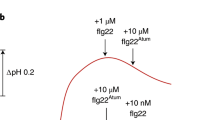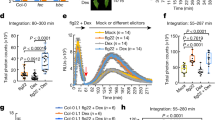Abstract
Plants and animals detect the presence of potential pathogens through the perception of conserved microbial patterns by cell surface receptors. Certain solanaceous plants, including tomato, potato and pepper, detect flgII-28, a region of bacterial flagellin that is distinct from that perceived by the well-characterized FLAGELLIN-SENSING 2 receptor. Here we identify and characterize the receptor responsible for this recognition in tomato, called FLAGELLIN-SENSING 3. This receptor binds flgII-28 and enhances immune responses leading to a reduction in bacterial colonization of leaf tissues. Further characterization of FLS3 and its signalling pathway could provide new insights into the plant immune system and transfer of the receptor to other crop plants offers the potential of enhancing resistance to bacterial pathogens that have evolved to evade FLS2-mediated immunity.
This is a preview of subscription content, access via your institution
Access options
Subscribe to this journal
Receive 12 digital issues and online access to articles
$119.00 per year
only $9.92 per issue
Buy this article
- Purchase on Springer Link
- Instant access to full article PDF
Prices may be subject to local taxes which are calculated during checkout





Similar content being viewed by others
References
Boller, T. & Felix, G. A renaissance of elicitors: perception of microbe-associated molecular patterns and danger signals by pattern-recognition receptors. Annu. Rev. Plant Biol. 60, 379–406 (2009).
Zipfel, C. Plant pattern-recognition receptors. Trends Immunol. 35, 345–351 (2014).
O'Neill, L. A., Golenbock, D. & Bowie, A. G. The history of Toll-like receptors – redefining innate immunity. Nat. Rev. Immunol. 13, 453–460 (2013).
Rossez, Y., Wolfson, E. B., Holmes, A., Gally, D. L. & Holden, N. J. Bacterial flagella: twist and stick, or dodge across the kingdoms. PLoS Pathog. 11, e1004483 (2015).
Asai, T. et al. MAP kinase signalling cascade in Arabidopsis innate immunity. Nature 415, 977–983 (2002).
Rosli, H. G. et al. Transcriptomics-based screen for genes induced by flagellin and repressed by pathogen effectors identifies a cell wall-associated kinase involved in plant immunity. Genome Biol. 14, R139 (2013).
Sun, Y. et al. Structural basis for flg22-induced activation of the Arabidopsis FLS2-BAK1 immune complex. Science 342, 624–628 (2013).
Gomez-Gomez, L. & Boller, T. FLS2: an LRR receptor-like kinase involved in the perception of the bacterial elicitor flagellin in Arabidopsis. Mol. Cell. 5, 1003–1011 (2000).
Chinchilla, D. et al. A flagellin-induced complex of the receptor FLS2 and BAK1 initiates plant defence. Nature 448, 497–500 (2007).
Heese, A. et al. The receptor-like kinase SERK3/BAK1 is a central regulator of innate immunity in plants. Proc. Natl Acad. Sci. USA 104, 12217–12222 (2007).
Cai, R. et al. The plant pathogen Pseudomonas syringae pv. tomato is genetically monomorphic and under strong selection to evade tomato immunity. PLoS Pathog. 7, e1002130 (2011).
Clarke, C. R. et al. Allelic variation in two distinct Pseudomonas syringae flagellin epitopes modulates the strength of plant immune responses but not bacterial motility. New Phytol. 200, 847–860 (2013).
Veluchamy, S., Hind, S. R., Dunham, D. M., Martin, G. B. & Panthee, D. R. Natural variation for responsiveness to flg22, flgII-28, and csp22 and Pseudomonas syringae pv. tomato in heirloom tomatoes. PLoS ONE 9, e106119 (2014).
Tomato Genome Consortium . The tomato genome sequence provides insights into fleshy fruit evolution. Nature 485, 635–641 (2012).
Strickler, S. et al. Comparative genomics and phylogenetic discordance of cultivated tomato and close wild relatives. PeerJ 3, e793 (2015).
Sim, S. C. et al. High-density SNP genotyping of tomato (Solanum lycopersicum L.) reveals patterns of genetic variation due to breeding. PLoS ONE 7, e45520 (2012).
Zipfel, C. et al. Perception of the bacterial PAMP EF-Tu by the receptor EFR restricts Agrobacterium-mediated transformation. Cell 125, 749–760 (2006).
Martin, G. B. in Effectors in Plant-Microbe Interactions (eds Martin, F. & Kamoun, S. ) 123–154 (Wiley-Blackwell, 2012).
Andolfo, G. et al. Overview of tomato (Solanum lycopersicum) candidate pathogen recognition genes reveals important Solanum R locus dynamics. New Phytol. 197, 223–237 (2013).
Dardick, C., Schwessinger, B. & Ronald, P. Non-arginine-aspartate (non-RD) kinases are associated with innate immune receptors that recognize conserved microbial signatures. Curr. Opin. Plant Biol. 15, 358–366 (2012).
Bull, C. T. et al. Pseudomonas cannabina pv. cannabina pv. nov., and Pseudomonas cannabina pv. alisalensis (Cintas Koike and Bull, 2000) comb. nov., are members of the emended species Pseudomonas cannabina (ex Sutic & Dowson 1959) Gardan, Shafik, Belouin, Brosch, Grimont & Grimont 1999. Syst. Appl. Microbiol. 33, 105–115 (2010).
Carrera, A. C., Alexandrov, K. & Roberts, T. M. The conserved lysine of the catalytic domain of protein kinases is actively involved in the phosphotransfer reaction and not required for anchoring ATP. Proc. Natl Acad. Sci. USA 90, 442–446 (1993).
Schwessinger, B. et al. Phosphorylation-dependent differential regulation of plant growth, cell death, and innate immunity by the regulatory receptor-like kinase BAK1. PLoS Genet. 7, e1002046 (2011).
Kinoshita, T. et al. Binding of brassinosteroids to the extracellular domain of plant receptor kinase BRI1. Nature 433, 167–171 (2005).
Bauer, Z., Gomez-Gomez, L., Boller, T. & Felix, G. Sensitivity of different ecotypes and mutants of Arabidopsis thaliana toward the bacterial elicitor flagellin correlates with the presence of receptor-binding sites. J. Biol. Chem. 276, 45669–45676 (2001).
Mueller, K. et al. Contamination risks in work with synthetic peptides: flg22 as an example of a pirate in commercial peptide preparations. Plant Cell 24, 3193–3197 (2012).
Chaparro-Garcia, A. et al. The receptor-like kinase SERK3/BAK1 is required for basal resistance against the late blight pathogen Phytophthora infestans in Nicotiana benthamiana. PLoS ONE 6, e16608 (2011).
Roux, M. et al. The Arabidopsis leucine-rich repeat receptor-like kinases BAK1/SERK3 and BKK1/SERK4 are required for innate immunity to hemibiotrophic and biotrophic pathogens. Plant Cell 23, 2440–2455 (2011).
Schulze, B. et al. Rapid heteromerization and phosphorylation of ligand-activated plant transmembrane receptors and their associated kinase BAK1. J. Biol. Chem. 285, 9444–9451 (2010).
Xiao, F. et al. The N-terminal region of Pseudomonas type III effector AvrPtoB elicits Pto-dependent immunity and has two distinct virulence determinants. Plant J. 52, 595–614 (2007).
Broz, P. & Monack, D. M. Newly described pattern recognition receptors team up against intracellular pathogens. Nat. Rev. Immunol. 13, 551–565 (2013).
Lage, S. L. et al. Emerging concepts about NAIP/NLRC4 inflammasomes. Front Immunol. 5, 309 (2014).
Furukawa, T., Inagaki, H., Takai, R., Hirai, H. & Che, F. S. Two distinct EF-Tu epitopes induce immune responses in rice and Arabidopsis. Mol. Plant Microbe Interact. 27, 113–124 (2014).
Bardoel, B. W. et al. Pseudomonas evades immune recognition of flagellin in both mammals and plants. PLoS Pathog. 7, e1002206 (2011).
Pel, M. J. et al. Pseudomonas syringae evades host immunity by degrading flagellin monomers with alkaline protease AprA. Mol. Plant Microbe Interact. 27, 603–610 (2014).
Vinatzer, B. A., Monteil, C. L. & Clarke, C. R. Harnessing population genomics to understand how bacterial pathogens emerge, adapt to crop hosts, and disseminate. Annu. Rev. Phytopathol. 52, 19–43 (2014).
Lacombe, S. et al. Interfamily transfer of a plant pattern-recognition receptor confers broad-spectrum bacterial resistance. Nat. Biotechnol. 28, 365–369 (2010).
Tripathi, J. N., Lorenzen, J., Bahar, O., Ronald, P. & Tripathi, L. Transgenic expression of the rice Xa21 pattern-recognition receptor in banana (Musa sp.) confers resistance to Xanthomonas campestris pv. musacearum. Plant Biotechnol. J. 12, 663–673 (2014).
Afroz, A. et al. Enhanced resistance against bacterial wilt in transgenic tomato (Lycopersicon esculentum) lines expressing the Xa21 gene. Plant Cell Tiss. Organ Cult. 104, 227–237 (2011).
Mendes, B. M. J. et al. Reduction in susceptibility to Xanthomonas axonopodis pv. citri in transgenic Citrus sinensis expressing the rice Xa21 gene. Plant Path. 59, 68–75 (2010).
Holton, N., Nekrasov, V., Ronald, P. C. & Zipfel, C. The phylogenetically-related pattern recognition receptors EFR and XA21 recruit similar immune signaling components in monocots and dicots. PLoS Pathog. 11, e1004602 (2015).
Lu, F. et al. Enhancement of innate immune system in monocot rice by transferring the dicotyledonous elongation factor Tu receptor EFR. J. Integr. Plant Biol. 57, 641–652 (2015).
Schoonbeek, H. J. et al. Arabidopsis EF-Tu receptor enhances bacterial disease resistance in transgenic wheat. New Phytol. 206, 606–613 (2015).
Schwessinger, B. et al. Transgenic expression of the dicotyledonous pattern recognition receptor EFR in rice leads to ligand-dependent activation of defense responses. PLoS Pathog. 11, e1004809 (2015).
Velasquez, A. C., Chakravarthy, S. & Martin, G. B. Virus-induced gene silencing (VIGS) in Nicotiana benthamiana and tomato. J. Visualiz. Exper. 28, 1292 (2009).
Felix, G., Duran, J. D., Volko, S. & Boller, T. Plants have a sensitive perception system for the most conserved domain of bacterial flagellin. Plant J. 18, 265–276 (1999).
Kunze, G. et al. The N terminus of bacterial elongation factor Tu elicits innate immunity in Arabidopsis plants. Plant Cell 16, 3496–3507 (2004).
Mathieu, J., Schwizer, S. & Martin, G. B. Pto kinase binds two domains of AvrPtoB and its proximity to the effector E3 ligase determines if it evades degradation and activates plant immunity. PLoS Pathog. 10, e1004227 (2014).
Broghammer, A. et al. Legume receptors perceive the rhizobial lipochitin oligosaccharide signal molecules by direct binding. Proc. Natl Acad. Sci. USA 109, 13859–13864 (2012).
Acknowledgements
We thank E. van der Knapp for providing tomato seeds, H.-L. Wei for DC3000 strains, J. Debbie for assistance with analysis of the FLS3 sequences from various tomato cultivars, C. Kraus and S. Schwizer for testing FLS3 expression in Arabidopsis thaliana, S. Schwizer and J. Mathieu for DNA constructs and S. Schwizer for proofreading. This research was supported by grants from the National Science Foundation to G.B.M. (IOS-1025642) and B.A.V. (IOS-1354215), the USDA-National Initiative in Food and Agriculture (2010-65108-20503) to G.B.M., the USDA Binational Agriculture Development Fund (IS-4931-16C) to G.B.M. and the National Institutes of Health (R01-GM078021) to G.B.M.; by the TRIAD foundation to G.B.M. and F.C.S.; by a Postdoctoral Fellowship from the Human Frontiers Science Program to P.C.B.; by a summer REU stipend to E.G.V. (National Science Foundation REU Site award DBI-1358843); and by internal funding from the Boyce Thompson Institute to S.R.S.
Author information
Authors and Affiliations
Contributions
S.R.H. and G.B.M. conceived, designed and analysed experiments; S.R.H. performed the experiments except as noted below. S.R.S. designed and performed the bioinformatics analyses, and assisted with primer design. D.M.D. performed some of the experiments shown in Fig. 2 and Supplementary Figs 5, 6 and 8. P.C.B., I.M.O. and J.A.B. conceived and designed the experiments shown in Fig. 4 and Supplementary Fig. 7. Z.B. cloned, sequenced and analysed the FLS3 genomic sequences from tomato cultivars and S. pimpinellifolium accessions. E.G.V. performed the experiments shown in Fig. 2a,b. I.M.O., J.A.B. and F.C.S. provided technical assistance and advice in the development and application of crosslinking and click chemistry conditions, and I.M.O., J.A.B. and J.S.H. designed and synthesized the chemistries needed for the peptide probe generation. B.A.V. and C.R.C. designed and C.R.C. performed the experiments in Supplementary Fig. 1d–f. S.R.H. and G.B.M. wrote the manuscript with input from all co-authors.
Corresponding author
Ethics declarations
Competing interests
The authors declare no competing financial interests.
Supplementary information
Supplementary Information
Supplementary Figs 1–8, Supplementary Tables 1 and 2, Supplementary Methods and Materials, and Supplementary References. (PDF 2733 kb)
Rights and permissions
About this article
Cite this article
Hind, S., Strickler, S., Boyle, P. et al. Tomato receptor FLAGELLIN-SENSING 3 binds flgII-28 and activates the plant immune system. Nature Plants 2, 16128 (2016). https://doi.org/10.1038/nplants.2016.128
Received:
Accepted:
Published:
DOI: https://doi.org/10.1038/nplants.2016.128
This article is cited by
-
Loss-of-function mutations in WRKY22 and WRKY25 impair stomatal-mediated immunity and PTI and ETI responses against Pseudomonas syringae pv. tomato
Plant Molecular Biology (2023)
-
Genomic structural variation in tomato and its role in plant immunity
Molecular Horticulture (2022)
-
Nobel adjacency
Nature Plants (2022)
-
Genotyping-by-sequencing-based identification of Arabidopsis pattern recognition receptor RLP32 recognizing proteobacterial translation initiation factor IF1
Nature Communications (2022)
-
The simultaneous perception of self- and non-self-danger signals potentiates plant innate immunity responses
Planta (2022)



